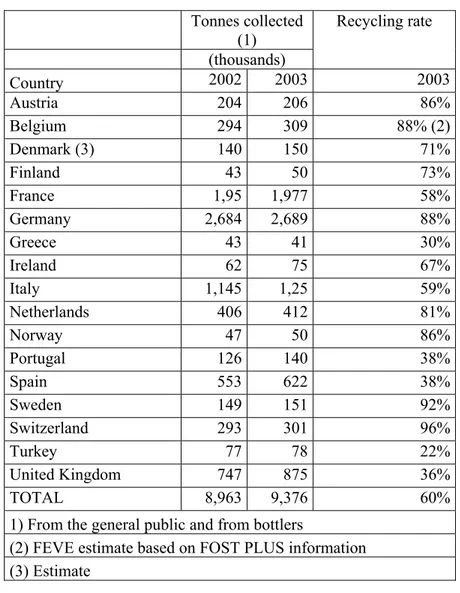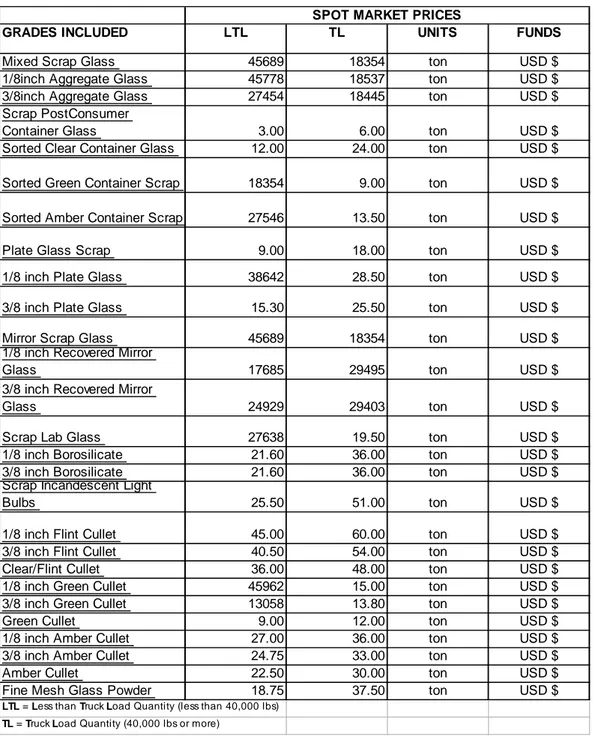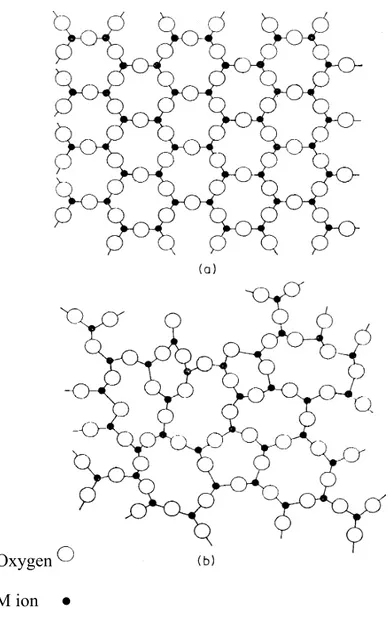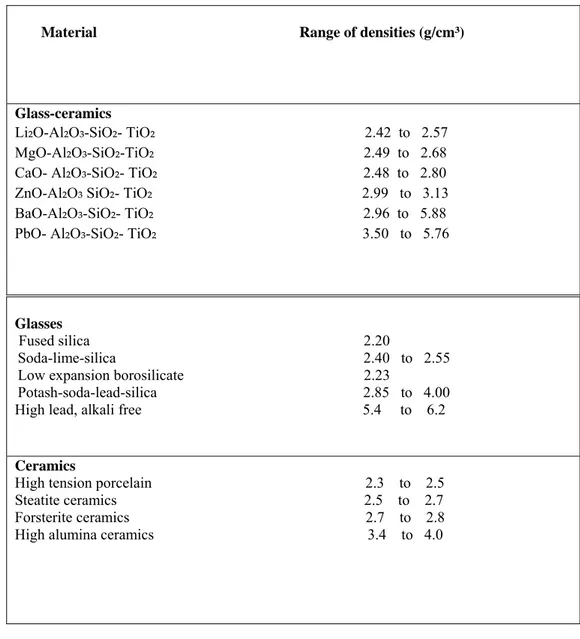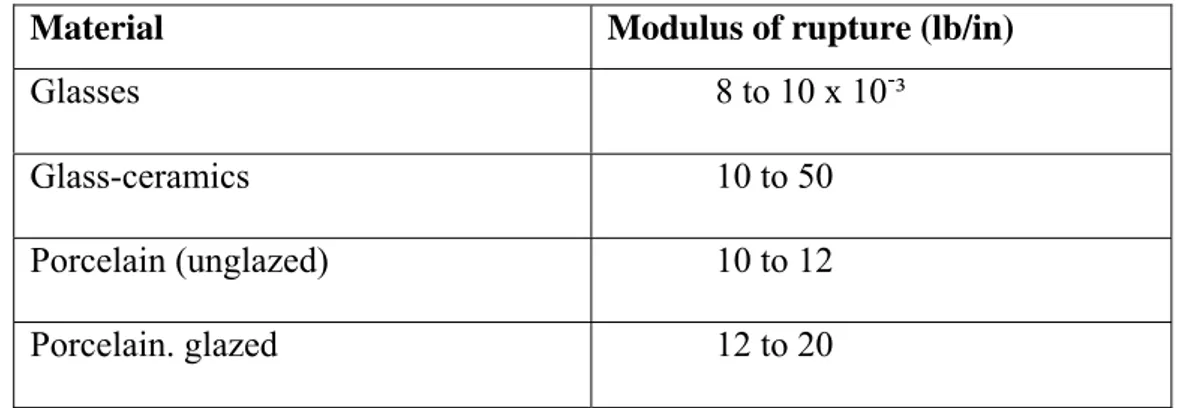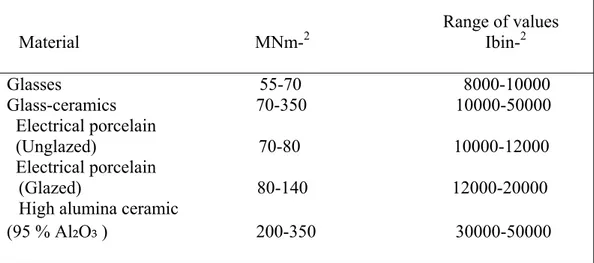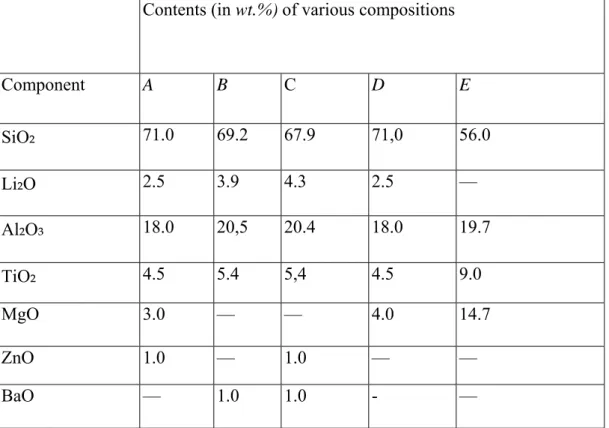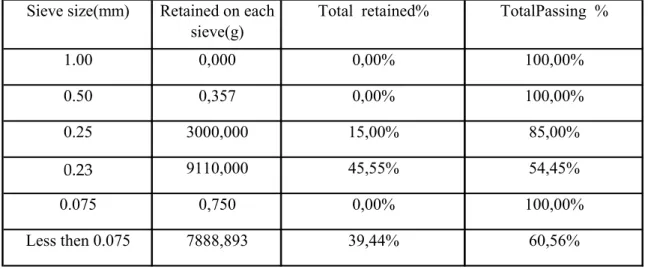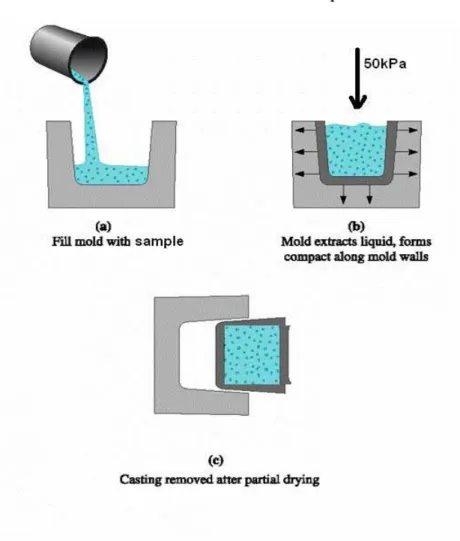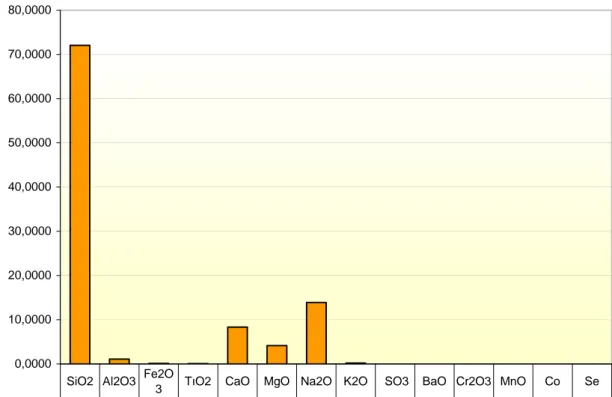TC ISTANBUL KULTUR UNIVERSITY INSTITUTE OF SCIENCE
EFFECT OF PARTICLE SIZE ON
SOME PHYSICAL PROPERTIES OF GLASS CERAMIC TILES
Master of Science Thesis by
Nozhat Moftah
ELBUAISHI
Department: Civil Engineering Program: Civil Engineering
TC ISTANBUL KULTUR UNIVERSITY INSTITUTE OF SCIENCE
EFFECT OF PARTICLE SIZE ON
SOME PHYSICAL PROPERTIES OF GLASS CERAMIC TILES
Master of Science Thesis by
Nozhat Moftah
ELBUAISHI
(0209010008)
Date of Submission: 3 June 2005 Date of Defence Examination: 12 August 2005
Supervisor and Chairperson: Ass. Prof.Dr Nihal Sarier Members of Examining Committee: Yrd.Doç.Dr. Hasan Biricik
Yrd.Doç.Dr.Erdal Çoşkun
Supervisor: Ass. Prof.Dr Nihal Sarier
ACKNOWLEDGEMENTS
I would like to express my most sincere gratitude to my advisor Dr. Nihal Sarier, who guided and encouraged me through this investigation.
I also want to thank to Dr. Celal Ustaer and Dr. Hasan Biricik for their unconditional help during this investigation.
I also would like to express my gratitude to Prof.Dr.Turgut Uzel ,who is in charge of IKU Science Institute, and Prof.Dr.Okay Eroskay, who is the Dean of Faculty of Engineering and Architecture.
I would like to emphasize my deepest appreciation to Prof.Dr.Hasan Karataş who was one of the best instructors that I have ever met.
Many thanks to BETEBE Factory, which maintained the glass cullet raw material for my experimental study, and also shared their valuable experience with me.
Special thanks to Libya Jamahiriy government and Libya Jamahiriy Embassy for providing the scholarship that made this investigation possible.
My special thanks to my husband Elayadi, for his patience and comprehension throughout these three years .
TABLE OF CONTENT
Acknowledgements...i
Table of Content ...ii
Table List...iii Figure List...iv Abbreviations………v Özet...vi Abstract...vii 1. Introduction... 1
1.1. Economical and Enivironmental Aspects of Glass Recycling Industry... 2
1.2. Glass-Ceramics: Definition and History... 7
1.3. Glass-Formers... 11
1.4. Chemical Compositions of Glass Ceramics...… 11
1.5. The Preparation of Glass... 13
1.6. Properties of Glass-Ceramics... 16
1.7. Scientific Importance of Glass Ceramics... 22
1.8. Technological Significance Of Glass Ceramics...23
1.9. Production Technology of Glass Ceramics... 24
1.10.Application of Glass Ceramics...26
2. EXPERIMENTAL... 28
2.1. Aim of The Study...28
2.2. Materials...28
2.3. Methods...28
3. RESULTS and DISCUSSION...32
TABLE LIST
Table 1.1. European Glass Recyling in 2003... 4 Table 1.2. Glass Recycling Market Prices in Asia Countries... 5 Table 1.3. Amounts of Packaging Waste (Tons/Annum) Recovered and Recycled in Turkey...……… 6 Table 1.4. Common Glass Ceramic System... 10 Table 1.5. Densities of Glass Ceramic, Glasses and Conventional Ceramics…….18 Table 1.6. Strength of Glasses, Glass-Ceramics and Ceramics... 19 Table 1.7. Modulus of Rupture Values for Glass-Cerami Other Materials... 21 Table 1.8. Concentration of Pigments and the Color of Pigmented Glass-Ceramic25 Table 2.1. The Sieve Analysis of Powdered Glass... 30 Table 2.2. The Particle Size Distribution and the Preparation Conditions of the Samples Initially...…… 33 Table 2.3. The Particle Size Distribution and the Preparation Conditions of the Samples finally………...35
FIGURE LIST
Figure 1.1. Two- Dimensional Representation of an Oxide M203...…. 9
Figure 1.2. Variation of Strength With Temperature for Glass Ceramics
and a Typical Glass ...……… 19 Figure 2.1. Preparation of the Glass-Ceramic Samples... 31 Figure 2.2. Chemical Composition of the Glass Used in Experiment... 32 Figure 2.3. Stereomicroscope Pictures of the Samples at 750oC for 60min.... 34 Figure 2.4. Streomicroscope Pictures of the Samples at Different Temperatures and Different Sinterization...……..37- 38- 39
ABBREVIATIONS
DTA- :Differential thermal analysis TG :Thermogravimetry
XRF :X-Ray- Fluorescence
A.S.T.M : American Society for Testing and Materials (glass Thermometer)
ÖZET
Cam amorf, kimyasal tepkimeye girmeyen, gözenekli olmayan bir maddedir. Hijyeniktir ve kolayca geri dönüştürülebilir. Camın yığın (bulk) yoğunluğu yaklaşık olarak 1.300 kg/m3 ve özgül ağırlığı 2.500 kg/m3 tür. Geridönüştürülmüş camın özellikleri de farklı değildir. Çeşitli sanat ve dekoratif uygulamalar için kullanılabilir. Cam seramik yapmanın etkin bir yolu atık camdan yararlanmaktır. Cam seramik karolar duru beyazdan siyaha kadar uzanan çok farklı renklerde oluşturulabilir, görünümleri doğal taşlara benzer olarak bile hazırlanabilir. Bu karolar binaların iç ve dış kaplamasında kullanılmaktadır.
Ambalaj malzemelerinin geri dönüşümü pek çok ülkede yeni bir kavramdır. Son yirmi yıldır geri dönüşüm endüstrisinde dikkat çekici değişimler ve uygulamalar gözlenmektedir. İyi işleyen bir geri dönüşüm sisteminin oluşturulması için ekonomik ve yasal çalışmalarla gönüllü çabalar gereklidir. Geridönüştürülmüş cam kullanımı hem ham maddede hem de camı eritmek için gerekli enerjide kayda değer bir tasarruf sağlar. Ham maddeden cam üretimi için gerekli olan enerjinin % 5 ‘i geridönüşmüş cam kullanılirsa yeterli olmaktadır. Bu da kuşkusuz önemli bir tasarruftur.
Bu çalışmada, geridönüşmüş camın öğütülmesi ile elde edilen cam ham maddenin tane iriliği dağılımının uzun ömürlü , ışık geçirgenliği yüksek ve homojen görünümlü cam seramik karo üretimine etkisi incelenmiştir. Daha sonra, tane iriliğinin, sinterleşme sıcaklığı ve süresinin cam seramik karoların mikro yapısına etkisi polarize mikroskop görüntüleri ile çalışılmıştır. Ham madde olarak kullanılan camın kimyasal bileşimi XRF yöntemi ile saptanmıştır.
Tane iriliği seçiminin, sıcaklık aralığının ve sinterleşme süresinin cam seramiklerin mikroyapısını, dolayisiyle mekanik ve optik özelliklerini etkileyeceği sonucuna varılmıştır.
0.25 mm tane iriliği aralığından % 50 ve 0.075 mm tane iriliği aralığından % 50 oranında alınarak harmanlanan ham cam karışımının cam seramik hazırlanmasında uygun tane iriliği aralıklardan bir olduğu söylenebilir. Sinterleşme sıcaklığı 800°C ve uygulanabilir sinterleşme süresi 15 dakika olarak belirlenmiştir.
Gelecek çalışmalarda renk verici ağır metal oksidlerinin, sinterleşme sıcaklığını düşüren PbO ya da B₂ O₃ bileşiklerinin belirli tane iriliği aralığındaki ham maddeye eklenerek, bu değişkenlerin sinterleşme sıcaklığına, süresine ve mikroskobik özelliklere etkisi incelenebilir. Ayrıca mikroskobik çalışmaları desteklemek amacı ile DTA- TG yöntemleri ile ısıl değişim incelemeleri yapılabilir.
ABSTRACT
Glass is an amorphous, chemically inert, non-porous material, It is hygenic and readily recyclable. The bulk density of glass is approximately 1.300 kg/m3 and the specific gravity is 2.500 kg/m3 . Recycled glass is not different and is used in a variety of art and decorative applications.
Forming glass-ceramic is an effective way to make use of waste glass. Glass ceramic tiles can be produced in the complete color range, from clear white to black, including the appearance of natural stones.The tiles can be used for both external and internal tiling of buildings.
Recycling of packaging material is a recent concern for many countries and the last 20 years have seen remarkable changes and applications in the recycling industry. Economic, legal and voluntary efforts are necessary to establish a well running system. The use of recycled glass can achieve considerable savings in raw material and the energy needed to melt the glass. 5% of the energy that is required to manufacture glass from raw materials is saved, which is a significant saving.
In this study, the effect of the particle size of glass on the formation of the specimens in order to get long life glass ceramic tiles with transparent and homogeneous feature is examined. Then, in order to observe the effect of particle size, temperature and duration of sinterization on the microstructure of glass ceramic tiles, polarized microscope photographs were studied. The chemical composition of the raw glass sample was also determined by using XRF instrument.
We can conclude that the particle size selection, the temperature range and the duration of sinterization affect the microscopic structure of glass – ceramics, therefore the mechanical properties and optical properties.
It can be proposed that the mixture of 50% 0.25mm and 50% 0.075mm raw glass is one of the suitable compositions for glass- ceramic preparation.
The temperature for complete sinterization was determined as 800°C and the applicable duration of sinterization was 15 minutes.
In future studies different materials such as coloring heavy metal oxides, fluxes of PbO or B₂ O₃ will be added to the mixtures, and their effects on the sinterization temperature duration, and on the microscopic properties will be studied. Additional thermal analysis studied as DTA- TG will be used to support the microscopic studies.
1. INTRODUCTION
Glass is an amorphous, chemically inert, non-porous material, It is hygenic and readily recyclable. The bulk density of glass is approximately 1.300 kg/m3 and the specific gravity is 2.500 kg/m3.
Recycled glass is not different and is used in a variety of art and decorative applications . Forming glass-ceramic is an effective way to make use of waste glass. Glass ceramic tiles can be produced in the complete color range, from clear white to black, including the appearance of natural stones, e.g. granite or marble.
The tiles can be used for both external and internal tiling of buildings, swimming pools, water reservoirs, luxury interiors of hotels, industrial and manufacturing plants, food processing plants or health service institutions.
In the production of glass ceramics as building material , glass wastes are: 1) Grinded
2) Powdered and mixed with inorganic oxides for coloring.
The mixture is pressed in the molds of different sizes, and then heated for sinterization at high temperatures, The product , called glass-ceramic, has been used as wear resistant building material because of its hardness, chemical resistance, refractive and dispersive powers, compressive and tensile strengths, its low coefficient of thermal expansion, as well as its shiny colorful appearance.
1.1. Economical and Environmental Aspects of Glass Recycling Industry
Recycling of packaging material is a recent concern for many countries and the last 20 years have seen remarkable changes and applications in the recycling industry. However, recycling of materials is not a new concept for the Anatolian civilization,glass recycling has a history of more than a thousand years. Among the oldest and most important object was the recycled glass found in a shipwreck. Around A.D 1025 a merchant ship of uncertain origin, sank at 36 meters in the confines of Serçelimani, a natural harbor on the Southern Mediterranean Coast of Turkey.
The cargo of the ship was approximately three tons of cullet. These glasses included two tons of raw glass blocks, deliberately broken down to pieces ranging in sizes from tiny chips to large chunks up to 30 centimeters across. Another tonne obviously came from broken glass containers from various sources. As well as some 80 glass vessels found intact in the living quarters.
Both the intact glassware and glassware cullet appear to have been produced at just one locale within the Moslem world. The Palastine-Lebanese coast was in Fatimid times, as it was before and after one of the most important centers for the manufacture and export of glass. The eastern Mediterranean glasses were famous for its fine quality and thus, particularly desirable even as cullet.
The findings indicate that some may have been collected by merchants who went from house to house buying broken bottles and pots. This collection method is called “kerbside collection” in recycling terminology today. Many countries would like to develop these in big cities. Other fragments were clearly waste from glass making workshops.
These pieces are now being restored by a team of Turkish conservators and members of the Institute of Nautical Archeology at the Museum of Underwater Archeology at Bodrum. (1)
Economic, legal and voluntary efforts are necessary to establish a well running system.
The use of recycled glass can achieve considerable savings in raw material and the energy needed to melt the glass. 5% of the energy that is required to manufacture glass from raw materials is saved. This is a significant saving, as glass is manufactured in huge furnaces at temperatures exceeding 1500 0 C, and the energy cost is immense.
On the other hand, glass manufacturers are continuously reformulating to reduce costs of raw materials, reduce melting temperature. Figures from The European Glass Container Federation , FEVE, showed that the amount of container glass collected for recycling in 2003, in Europe was about 6.7million tonnes .Since then , every year recycled glass amount is to increase by 4.6 % . The European glass recycling recent values are given in Table1.1. ( 2 )
Table 1.1 European Glass Recycling in 2003 Tonnes collected (1) (thousands) Recycling rate Country 2002 2003 2003 Austria 204 206 86% Belgium 294 309 88% (2) Denmark (3) 140 150 71% Finland 43 50 73% France 1,95 1,977 58% Germany 2,684 2,689 88% Greece 43 41 30% Ireland 62 75 67% Italy 1,145 1,25 59% Netherlands 406 412 81% Norway 47 50 86% Portugal 126 140 38% Spain 553 622 38% Sweden 149 151 92% Switzerland 293 301 96% Turkey 77 78 22% United Kingdom 747 875 36% TOTAL 8,963 9,376 60%
1) From the general public and from bottlers
(2) FEVE estimate based on FOST PLUS information (3) Estimate
Glass recycling up to date market prices for Asia countries including Turkey are given in Table 1.2. (3)
Table 1.2. Glass Recycling Market Prices in Asia Countries
GRADES INCLUDED LTL TL UNITS FUNDS
Mixed Scrap Glass 45689 18354 ton USD $
1/8inch Aggregate Glass 45778 18537 ton USD $
3/8inch Aggregate Glass 27454 18445 ton USD $
Scrap PostConsumer
Container Glass 3.00 6.00 ton USD $
Sorted Clear Container Glass 12.00 24.00 ton USD $
Sorted Green Container Scrap 18354 9.00 ton USD $
Sorted Amber Container Scrap 27546 13.50 ton USD $
Plate Glass Scrap 9.00 18.00 ton USD $
1/8 inch Plate Glass 38642 28.50 ton USD $
3/8 inch Plate Glass 15.30 25.50 ton USD $
Mirror Scrap Glass 45689 18354 ton USD $
1/8 inch Recovered Mirror
Glass 17685 29495 ton USD $
3/8 inch Recovered Mirror
Glass 24929 29403 ton USD $
Scrap Lab Glass 27638 19.50 ton USD $
1/8 inch Borosilicate 21.60 36.00 ton USD $
3/8 inch Borosilicate 21.60 36.00 ton USD $
Scrap Incandescent Light
Bulbs 25.50 51.00 ton USD $
1/8 inch Flint Cullet 45.00 60.00 ton USD $
3/8 inch Flint Cullet 40.50 54.00 ton USD $
Clear/Flint Cullet 36.00 48.00 ton USD $
1/8 inch Green Cullet 45962 15.00 ton USD $
3/8 inch Green Cullet 13058 13.80 ton USD $
Green Cullet 9.00 12.00 ton USD $
1/8 inch Amber Cullet 27.00 36.00 ton USD $
3/8 inch Amber Cullet 24.75 33.00 ton USD $
Amber Cullet 22.50 30.00 ton USD $
Fine Mesh Glass Powder 18.75 37.50 ton USD $
LTL = Less than Truck Load Quantity (less than 40,000 lbs) TL = Truck Load Quantity (40,000 lbs or more)
SPOT MARKET PRICES
Solid waste recovery and recycling has been a long-standing commercial activity in Turkey. Glass recycling is being conducted at an industrial scale since 1950’s. Annually , amount of glass in markets is about 350 000 tons, waste glass collected for recycling is 80 000 tons , and the rate of recycling glass is 25 % in Turkey. (Table 1.3)(4,5)
Table 1.3. Amounts of Packaging Waste (tons/annum) Recovered and Recycled in Turkey
Material Kind Market Figures (Tons) Amount Recovered (Tons) % Recycled Paper& Board 1.850.000 700.000 36% Glass 350.000 80.000 25% Plastics 550.000 170.000 30% Metal 150.000 50.000 30% Total 2.900.000 1.000.000 35%
1.2. Glass- Ceramics: Definition and History
i) Glass
Glass might be described as a transparent substance possessing the properties of hardness, rigidity and brittleness.
Thus, with the possible exception of transparency, the properties usually thought of as characterising glass are those normally associated with solids. As we shall see, however, glass possesses a number of properties, which are characteristic of the liquid state and the classification of glass as a liquid of very high viscosity rather than a solid would be in accordance with modern views.
Various definitions of glass have been put forward but one which is widely accepted is that proposed by the A.S.T.M.: glass is an inorganic product of fusion, which has cooled to a rigid condition without crystallizing (6).
There are many properties of glass, which confirm its liquid-like nature. For example, the transparency of glass may be thought of as a property more usually characteristic of the liquid state than of the solid crystalline state. The transparency
could cause scattering of light. The X-ray diffraction pattern of glass shows only diffuse holes as compared with the sharp pattern of lines given by a crystalline substance.
Glass is isotropic; that is, its properties are the same regardless of the direction in which they are measured. Isotropy is more characteristic of a liquid structure than of a crystalline structure. The structure of glass is permeable to small particles such as sodium ions so that it behaves as an electrolytic conductor and this is associated with the rather "open" liquid-like structure. Similarly,
Certain glasses are permeable to the smaller gaseous atoms such as those of hydrogen and helium.
Glass is made up of silica which has a very high melting point. Glass structure has a random network in three dimensions but no unit repeats itself at regular distances. The basic unit is a tetrahedral or triangular co-ordination of silicon with oxygen. A few elements (B, P, Ge, and few others) also occupy some points in the network . During recycling , to decrease the sinterization temperature some fluxers can be used. When these fluxers are added to a silica glass the network continuity breaks down partially.
Glasses are characterized by certain properties, which are common to all of them and different from those of liquids and crystalline solids. Unlike crystals, glasses do not have a sharp melting point and do not cleave in preferred directions. Like crystalline solids they show elasticity (Figure1.1).
As a conclusion a glass is a state of matter which maintains the energy, volume and atomic arrangement of a liquid, but for which the changes in energy and volume with temperature and pressure are similar in magnitude to thoseof a crystalline solid. ii) Glass-ceramics:
Glass-ceramics are polycrystalline solids prepared by the controlled crystallization of glasses. Crystallization is accomplished by subjecting suitable glasses to a carefully regulated heat-treatment schedule, which results in the nucleation and growth of crystal phases within the glass. In many cases, the crystallization process can be taken almost to completion but a small proportion of residual glass-phase is often present.
Glass-ceramics can be produced from a wide range of glass types, some of the most important of which are given in Table 3. Materials having widely different and useful properties are possible. For example, glass-ceramics have been produced having thermal expansion coefficients ranging from negative values to high positive values close to those of metals such as steel or copper.
In glass-ceramics, the crystalline phases are entirely produced by crystal growth from a homogenous glass phase and this distinguishes these materials from traditional ceramics where most of the crystalline material is introduced when the ceramic composition is prepared Glass-ceramics are distinguished from glasses by the presence of major amounts of crystals since glasses are amorphous or noncrystalline. The development of practical glass-ceramics is comparatively recent although it has long been known that most glasses can be devitrified if they are heated for a sufficient length of time at a suitable temperature. This knowledge led to the early attempts by Reaumur, a French chemist, to produce polycrystalline materials from glass. He showed that glass bottles were packed into a mixture of sand and gypsum and subjected to heat for several days they were converted into opaque porcelain-like objects.
Although Reaumur was able to convert glass into a polycrystalline ceramic, he was unable to achieve the control of the crystallization process which is necessary for the production of true glass-ceramics. The materials produced by his process had low mechanical strengths and distortion of the articles during the heat-treatment process could occur (7).
Two –dimensional representation of an oxide M₂ O₃ in (a) the crystalline form (b) the glassy form/ About 200years after Reamer’s work, research carried out at corning glass works in the United States led to the development of glass- ceramics in their present form important step was the discovery of photosensitive glasses.
These contain small amounts of copper, silver or gold, which can be precipitated in the form of very small crystals during heat- treatment of the glasses.
Oxygen
M ion ●
Fig 1.1 Two –Dimensional Representation of an Oxide M₂ O₃
The first essential structural requirement of a commercial glass- ceramic is that it can be melted and formed easily and without harm to the furnace refractoriness. A second essential requirement is that the glass can be nucleated and crystallized quickly and economically to get the desired type of crystal.
The heating schedule also need not be too accurately controlled. Crystallization must, not be too rapid as uncontrolled crystal growth induces strains in the resulting glass-ceramic, which reduces its mechanical strength. A third, highly important requirement is that the resulting glass-ceramic has the desired properties. Today many compositions are known which crystallize to give a glass-ceramic, but for
commercial success they must have: (1) High mechanical strength.
(2) Low thermal expansion, or some matched expansion.
(3) Good chemical durability, and (4) very high or low, electrical conductivity.
Table 1.4. Common Glass Ceramic System
SYSTEM NUCLEATING CRYSTAL PHASES
Li ₂ O-Al₂ O₃-SiO₂ TiO₂; TiO₂ +P₂O₅+ Zr O₂ ß-spodumene/ßeucr- (AL₂O₃ >10%) yptite solid solution Li₂O-Al₂O₃-SiO₂ P₂O ₅ Lithium disilicate, (Al₂ O₃ < 10%) quartz
Li ₂O- ZnO –pbO -SiO₂ P₂O ₅ Lithium disilicat lithium Zinc silicate,quartz MgO- Al₂ O₃-SiO₂ TiO ₂ Cordierite,cristoblite
Na₂ O- Ba O- Al₂ O₃-SiO₂ TiO₂ Nepheline,hexacelsi
ZnO - Al₂ O₃ -SiO₂ P₂O₅; TiO₂ Willemite
Some Definitions about Glass Ceramics:
1. Green ceramic - A ceramic that has been shaped into a desired form but has not yet been sintered.
2. Vitrification Sinterization - Melting, or formation, of a glass.
body is formed into a useful shape.
4. Firing - Heating a ceramic body at a high temperature to cause a ceramic bond to form.
5. Ceramic bond - Bonding ceramic materials by permitting a glassy product to form at high-firing temperatures.
1.3 Glass -Formers
The ability of a substance to form a glass dose not depends upon any particular chemical or physical property. It is now generally agreed that almost any substance, if cooled sufficiently fast, could be obtained in the glassy state: B₂O₃, SiO₂, GeO₂ and P₂O₅ readily form glasses on their own and are commonly known as glass formers for they provide they backbone in other mixed-oxide glasses. As₂O₃ and Sb₂O₃ also produce glass when cooled very rapidly: TeO₂. SeO₂, MoO₃, WO₃, Bi₂O₃, AL₂O₃ ,Ga₂O₃ and V₂O₅ will not form glass on their own. But each will do so when melted with a suitable quantity of a second oxide. (6)
1.4. Chemical Composition of Glasses
As we have seen, certain oxides, which can themselves be obtained in the glassy condition, are essential to the formation of multicomponent glasses. The most important glass-forming oxides are silica (SiO₂), bor oxide (B₂O₃) and phosphorous-pent oxide (P₂O₅). The great majority of commercial glasses are silicate and borosilicate compositions.
Discussing types of glass, reference was made to certain glass-forming systems, which are important for the production of glass-ceramics. Actual glass-ceramic compositions are usually more complex then the ternary systems which were described and it is the purpose of this section to discuss practical examples of glass-ceramics derived from various oxide systems.
i) Glass-Ceramics derived from the Li₂O-Al₂O₃-SiO₂ System: These compositions are of great importance, since photo sensitively nucleated glass-ceramics are of this
type, and other useful materials, including glass-ceramics having very low coefficients of thermal expansion are derived from this system.
The types of glass-ceramic composition and the nature of the secondary become clear by reference to practical examples. Titania-nucleated glass-ceramics of the Li₂O-Al₂O₃-SiO₂ type having thermal expansion coefficients less than 15 x 10-7 and in some cases approaching zero have been produced. The compositions of these materials fall within the weight percentage range: Si0₂: 53-75%; TiO₂: 3-7%; Li₂O: 2-15%; Al₂O₃: 12-36%
ii) Glass-Ceramics derived from the: MgO-Al₂O₃-SiO₂ System: These glass- ceramics are important because they can be entirely free from alkali metal ions so that outstanding electrical characteristics, including low dielectric losses and high resistivities, can be attained. Small proportions of alkali metal oxides and other constituents are sometimes included in the glasses to modify the characteristics, however. The major constituents of the glasses in weight percentages are in the range: SiO₂: 40-70%; Al₂O₃: 9-35%; MgO: 8-32%. In addition, the glasses contain a nucleation catalyst such as TiO₂ 7 to 15 % or P₂O₅ 0.5 to 6 %.
iii) Glass-Ceramics derived from the Li₂O-MgO-SiO₂ System: Metallic phosphates have been used to catalyze the crystallization of glasses having weight percentage compositions in the range: SiO₂: 51-88%; MgO: 2-27%; Li₂O:9-27% and P₂O₃: 0.56%, together with various constituents of a secondary nature. Glass-ceramics of the Li₂O-MgO-SiO₂ type are of interest since in certain cases they have unusually high thermal expansion coefficients (up to140xl0-7).
iv) Glass-Ceramics derived from the Li₂O-ZnO-SiO₂ System: Glass-ceramics possessing high mechanical strengths and other desirable properties can be produced from glasses of the lithium zinc silicate type. Suitable nucleation catalysts include metallic phosphates or metals such as copper, silver or gold.
The weight percentages of the major glass constituents liein the range: SiO₂: 34-81%; ZnO: 10-59%; LiO₂O: 2-27%, and these constituents should total at least 90 % of the glass composition. The nucleation catalysts include phosphorous-pent oxide 0-5 to 6%, gold 0.02 to 0.03 %; silver computed as AgCl 0.02 to 0.03 % or copper
computed as Cu₂O 0.5 to 1 %. In addition to the essential constituents, alkali metal oxides (Na₂O, K2O), alkaline earth oxides (MgO, CaO, and BaO), aluminum oxide
(Al₂O₃), boric oxide (B₂O₃) and lead oxide (PbO) can be present in the glasses in minor proportions.
1.5. The Preparation of Glasses
Glasses are made by heating together a mixture of raw materials (known as batch") at a sufficiently high temperature to permit the materials to react with one another and to encourage the escape of gas bubbles from the melt, this latter process is referred to as refining the glass: Upon completion of the refining process, the glass is cooled from the melting temperature to the working temperature where the glass has a higher viscosity. Various shaping methods can then be applied to the glass to produce articles of the required form (8,9).
i ) Raw Materials of Glass Manufacture
In selecting raw materials the most important aspect to be taken into account is the purity.
More specifically, the composition of the raw material must be constant within fairly close limits so that proper control of the glass composition can be exercised.
Economic considerations will also play an important part in the choice of materials so that while for the production of expensive types of glasses, such as optical glass, materials of very high purity will be employed, less expensive and somewhat less pure materials will be used for the cheaper types of glasses: In the case of glass-ceramics, material quite high purity will be used since some types of impurity, even in quite small concentrations, could affect the crystallization characteristics of the glass. The most important constituent of the glass is silica, since it is principal glass-forming oxide present in most glasses.
The chief source of silica in the glass batch is quartz sand and the best sands will have SiO₂ contents of 99.5 percent or higher. Small amounts of alumina, Al₂O₃ may be present and iron oxide, Fe₂O₃, will certainly be present. Although this oxide gives a greenish color to glass, its presence is not apparent in the opaque glass-ceramic. The alkaline earth oxides such as CaO and MgO are often introduced in the form of their naturally occurring carbonates-limestone the case of CaO and magnetite in the case of MgO. A dolomite limestone, which contains both calcium and magnesium carbonates, may also be used if the glass includes both oxides. Barium carbonate is a convenient source for barium oxide.
Aluminum oxide is often introduced in the from of hydratealuminum A1₂0₃. 3H₂O, may also be used. Feldspars, which have the general formula R₂O.Al₂O₃. 6SiO₂. also for source of alumina, either as potash feldspars, soda feldspars or mixed feldspars. The feldspars also introduce silica and alkali oxides in addition of the alkali content of a glass may be introduced in the form of a nitrate. This is useful since these compounds assist melting and refining of the glass and also act as oxidising agents where are required lithium oxide can be conveniently introduced as the carbonate Li₂CO₃, although economic considerations may dictate the use of a lithium-bearing mineral such as petalite or spodumene; these materials, in addition, introduce silica and alumina and the achievement of the desired glass composition may not always permit their use.
The usual sources of boric oxide are boric acid, B₂O₃. 3H₂O or borax Na₂ B₄. O₇. 10H₂O. Small amounts of arsenic or antimony oxides may be introduced as refining agent’s and. cerium dioxide is often used as an oxidising agent. In some glasses this oxide also exerts a refining effect.
ii) The Melting of Glasses
The raw materials are accurately weighed out and after uniform mixing are charged into a furnace maintained at the melting temperature which can range from 1250 to 1600°C, depending upon the glass composition.
Scrap glass of the correct composition, known as cullet, is often included with the batch since this assists in melting and homogenizing the glass: The glass can be melted in crucibles or pots, but for large-scale production melting is carried out in continuous furnaces by charging batch into one end of the furnace while molten glass is removed for shaping at the other end of the furnace. Furnaces of this type are known as tank furnaces and they may be heated by gas or oil flames or, in recent practice, by passing a heavy electric current through the molten glass.
The high temperatures in the glass-melting furnace cause vigorous reactions take place. The alkali carbonates react with the silica with the evolution of carbon dioxide, alkaline earth carbonates break down and the oxides are taken into solution and hydrates or nitrates also present break down, permitting the resulting oxides to combine with the siliceous melt.
Violent agitation of the molten mass occurs due to the escaping gases and this assist mixing and maintains the reactions at a high rate: Eventually, complete solution and fusion of the materials is effected and there remains the process of refining or freeing the melt from bubbles: Some refining occurs due to gas bubbles re-dissolving in the melt when it is cooled, and glass may contain appreciable amounts of dissolved gases Such as carbon dioxide, oxygen and sulphur dioxide.
The refining stage is followed by cooling the glass to its working temperature, which may be several hundred degrees below the refining temperature. In tank furnaces this accomplished by causing the glass to flow in to a separate cooler chamber of the furnace. Here the glass will be brought to as uniform temperature as possible so that will possess a uniform viscosity.
ii) Shaping Processes.
During the shaping of glass, internal stresses are produced due to the presence of temperature gradients within the glass during cooling, and these stresses must be removed by annealing or they may result in fracture of the glassware. Annealing is achieved by bringing the glass to a uniform temperature within the "annealing range" where its viscosity is about 1012 to 1014 poises:
The stresses are relaxed due to viscous flow and the glass is then cooled at a sufficiently slow rate to prevent the establishment of large temperature gradients
within it. The cooling rates, which can be employed, are determined by the thickness of the glassware being annealed. For thin glass ,the whole process may be completed in an hour or so but thick heavy pieces may require several hours or even days to ensure that any residual stresses are kept within safe limits.
1.6. Properties of Glass-Ceramic
Ceramic made by the controlled crystallization of glass have outstanding mechanical, thermal and electrical properties, and it is useful to compare the properties of glass-ceramics with those of related materials such as glasses or ceramics made by conventional methods. In addition, it is of value to consider how the properties of a glass-ceramic are related to its chemical composition, its crystallographic constitution and microstructure. (10,11,12,13)
i) Microstructure and Porosity
One of the important characteristics of glass-ceramics is the extremely fine particle size. This feature is responsible in a large measure for the valuable properties of the materials.
A glass-ceramic can have an almost ideal polycrystalline structure since, in addition to the fine texture, the crystals are fairly uniform in size and they are randomly oriented.
In general the average crystal size in useful glass-ceramics is not greater than a few microns. Materials with mean crystal sizes as small as 200 to 300 oA are known for some materials prepared by the crystallization of glasses, however, greater mean grain sizes are obtained especially where the nucleation density is low but such materials do not have good mechanical strengths.
ii) Density
The densities of glass-ceramics lie within a similar range to those for glasses or conventional ceramics, as is shown by the data given in Table 1.5.
various crystal and glass phases present. Since the volume change, which occurs during conversion from the glass state to the glass-ceramic, is usually small, it would be expected that the effects of various oxides upon the densities of glass-ceramics would be similar to those observed with conventional glasses. .
iii) Chemical Durability
The resistance of a material to chemical attack by water or other reagents is of considerable practical importance. The processes involved are often very complex and methods of studying chemical durability usually involve subjecting a sample of carefully controlled surface area to closely specified test conditions. Often, the process of attack is accelerated, by employing conditions of increased temperature and, in some cases, pressure.
Tests of this nature have indicated that glass-ceramics in general possess good chemical stability and that they compare favorably in this respect with other ceramic-type materials. (14)
Table 1.5. Densities of Glass– Ceramic, Glasses and Conventional Ceramics
Material Range of densities (g/cm³)
Glass-ceramics
Li₂O-Al₂O₃-SiO₂- TiO₂ 2.42 to 2.57 MgO-Al₂O₃-SiO₂-TiO₂ 2.49 to 2.68 CaO- Al₂O₃-SiO₂- TiO₂ 2.48 to 2.80 ZnO-Al₂O₃ SiO₂- TiO₂ 2.99 to 3.13 BaO-Al₂O₃-SiO₂- TiO₂ 2.96 to 5.88 PbO- Al₂O₃-SiO₂- TiO₂ 3.50 to 5.76
iv) Mechanical Properties
At room temperature glass-ceramics like ordinary glasses and ceramics materials, exhibiting no region of ductility or plasticity, and they show perfect elastic behavior up to the load, which causes failure.
The strength of glass is greatly dependent upon surface cracks, which act as stress multipliers. These reduce the strength of glass from a theoretical value of about one million to 10000lb/in²for bulk glass.
Generally glass-ceramics are stronger than ordinary glasses and most ventional ceramics as can be see in Table 1.6. (15)
Loss of strength with temperature is an important factor in the practical
Glasses
Fused silica 2.20
Soda-lime-silica 2.40 to 2.55 Low expansion borosilicate 2.23
Potash-soda-lead-silica 2.85 to 4.00
High lead, alkali free 5.4 to 6.2
Ceramics
High tension porcelain 2.3 to 2.5 Steatite ceramics 2.5 to 2.7 Forsterite ceramics 2.7 to 2.8 High alumina ceramics 3.4 to 4.0
application of glass-ceramics because it limits the temperatures at which they can be used. Two general trends are observed as shown in Figure .1.2.
(i) a general decrease of strength with temperature (curve1), and (ii) a decrease of strength followed by a small increase at higher temperature(curve 2)
Table 1.6. Strength of Glasses, Glass-Ceramics and Ceramic
Figure 1.2. also shows the behavior of a typical glass (curve3)
The possible reasons for the high mechanical strengths of glass-ceramics are: Conventional ceramics contain pores, which will weaken the material. Glass- ceramics, in general do not have such voids.
Fig 1.2. Variation of Strength with Temperature for Glass Ceramics (1 and 2) and a Typical Glass (3).
Glass-ceramics are generally more resistant to abrasion than ordinary glasses, and so are less susceptible to surface damage.
Material Modulus of rupture (lb/in)
Glasses 8 to 10 x 10-³
Glass-ceramics 10 to 50
Porcelain (unglazed) 10 to 12
In glasses a propagated crack travels through a single homogeneous phase; in a glass-ceramic the cracks being diverted, slowed down, or even stopped by phase boundaries. The crack may follow grain boundaries; the very fine grain size of glass-ceramics undoubtedly plays an important part in determining their mechanical properties.
The ability of a material to withstand sudden temperature changes without failure, are strongly influenced by the mechanical strength. Not only is it desirable to have a high mechanical strength at normal ambient temperatures but also to retain high strengths at elevated temperatures since quite often the material may be required to operate under such conditions: For these reasons it is necessary to know how the strength of a glass-ceramic is influenced both by its constitution and by external factors.
Before examining the mechanical strengths of glass-ceramics in detail there are certain general aspects of mechanical failure, which must be considered. At room temperature glass-ceramics, like ordinary glasses and ceramics, are brittle materials. This means that they exhibit no region of ductility or plasticity and that they show perfectly elastic behavior up to the load, which causes failure.
As a general rule the strengths of glass-ceramics are high compare with ordinary glasses and with other types of ceramics shown table1.7
(The values are those typically obtained for 0.5 cm diameter rod point loading)
v) The micro structural basis for the strengths of glass-ceramics
The mechanical strengths of glass-ceramics are higher than those of many conventional ceramics and glasses when comparison is made using specimens with the same abrasion treatment. The complete absence of pores has already been mentioned as factor contributing to high strength.
This, however, does not provide a sufficient explanation for the observed strengths and it seems that a combination of factors may be responsible. Where the crystal has a higher thermal expansion coefficient than the surrounding glass, the radial stresses in the glass will be tensile and the circumferential stresses compressive.
Table 1.7. Modulus of Rupture Values for Glass -Ceramics and other Materials Range of values Material MNm-2 Ibin-2 Glasses 55-70 8000-10000 Glass-ceramics 70-350 10000-50000 Electrical porcelain (Unglazed) 70-80 10000-12000 Electrical porcelain (Glazed) 80-140 12000-20000 High alumina ceramic
(95 % Al₂O₃ ) 200-350 30000-50000
vi) Thermal properties
The dimensional changes, which occur, with change of temperature are of great importance from a number of points of view. First, the coefficient of thermal expansion should be as low as possible to minimize strain resulting from temperature gradients within the material Second, a material joined to a different material must have a well-matched thermal expansion coefficient to prevent cracking of the joint on thermal changes.
1. Glass-ceramics derived from Li₂O-Al₂O₃-SiO₂ and CaO-Al₂O₃-SiO₂ glasses, with thermal expansion coefficients approaching zero, have been used for a number of products where resistance to a sudden change in temperature is essential. These include oven dishes, cooker hot plates, laboratory bench tops, pipes, and valves. An important engineering application is in the manufacture of large rotary heat exchangers for gas turbines.
2. Glass-ceramics of the PbO-ZnO-B₂O₃ type can be used for sealing together glasses of thermal expansion coefficient 90 x 10 oC and the manufacture of tubes for color televisions depends on the use of sealing materials of this type.
3. Glass-ceramics having high capture cross-sections for thermal neutrons have also been developed for use in reactor control rods. These include the oxides of cadmium, indium and boron.
4. Glass-ceramic coatings for steel processing vessels using in the food and chemical industries have proved to have better acid resistance, improved thermal shock resistance, and higher strengths than the conventional vitreous enamel coatings.
1.7 The Scientific Importance of Glass-Ceramics
The investigation and development of glass-ceramics are closely related to studies of nucleation and crystallization of super cooled liquids.
Glass is a very convenient medium for fundamental studies of this liquid has high viscosities so that the diffusion processes and atomic rearrangements, which control nucleation and crystal growth, occur relatively slowly. Because molten glass is a good solvent for most oxides, for certain metals and for some halides and other compounds, the effects of these, present as minor constituents, upon crystal nucleation and growth processes can be investigated. Such studies, in addition to their basic importance, are of considerable interest in relation to the development of glass-ceramic microstructures.
In addition to their value for the study of physical-chemical effects, glass- ceramics are also valuable for fundamental investigations of certain physical properties.
One important field concerns the investigation of mechanical strength and fracture processes for brittle solids. Glass-ceramics are especially valuable in such studies because they can be produced to have a very fine microstructure and in addition can contain a wide variety of crystal types. A further valuable possibility is that for identical chemical compositions, the degree of crystallinity can be varied from the amorphous glass at one extreme to the almost completely crystalline glass-ceramic at the other.
This latter possibility is of interest not only in studies of mechanical failure but also in the investigation of properties, which are dependent on diffusion processes, such as ionic conductivity.
Basic studies on glass-ceramic systems are of interest in connection with other areas of Materials Science. In the general field they are of importance because they offer
combinations of physical properties not available with other classes of materials. To the glass technologist, the development of glass -ceramics is of great interest not only because they extend the possible applications of glass-making techniques but also because the search for new glass-ceramics stimulates research into glass compositions and the relative stabilities of various types of glass.
1.8. The Technological Significance of Glass-Ceramics
The process of manufacturing a glass-ceramic involves the preparation first of a glass which is shaped in its molten or plastic state to produce articles of the required form: The glassware is next subjected to a controlled heat-treatment cycle, which brings about nucleation and crystallization of various phases so that the final product is polycrystalline ceramic. This method of making a ceramic material represents a radical departure from conventional ceramic manufacturing processes and it offers a number of important advantages.
Since molten glass can be obtained in a homogeneous condition, uniformity of chemical composition can easily be achieved for glass-ceramics. The homogeneity of the parent glass together with the controlled manner in which the crystals are developed results in ceramic materials having a very fine grained uniform structure free from porosity. This is beneficial in a number of ways since it favors the development of high mechanical strength and also results in good electrical insulating characteristics.
The use of glass working processes such as pressing, blowing or drawing offers certain advantages over the techniques available for shaping conventional ceramics. In general, the techniques used for shaping conventional ceramics, such as extrusion or slip-casting, are slower than glass-shaping methods the ceramic ware usually requires extended drying and firing periods to avoid distortion and cracking. The advantages of the glass-ceramic process are particularly apparent in the production of thin-walled hollowware and other shapes where the section of the material is small since unfired conventional ceramic articles of this type are fragile, while the parent glass articles in the glass-ceramic process are relatively strong.
occurs. However, this change is small and is controllable so that control of the shape and dimensions of the glass-ceramic article can be achieved without too much difficulty. With conventional ceramics, relatively large shrinkages (40 to 50 % by volume) occur during the drying and firing operations and these dimensional changes may be accompanied by distortion.
In recent years, important advances have taken place in the control of glass- ceramic microstructures resulting, for example, in the development of machinable glass-ceramics and in the production of bulk and fibrous glass-glass-ceramics having orientated microstructures.
Glass-ceramics have become established as commercially important materials in fields such as consumer products, vacuum tube envelopes, and telescope mirror blanks, radomes for the aerospace industry and protective coatings for metals.
Glass-ceramics can be regarded as a most valuable addition to the materials available to the design engineer. Being inorganic and non-metallic they combine useful high temperature capabilities with a high degree of chemical stability and corrosion resistance.
Their unique combination of properties is likely to make them attractive for a number of specialised engineering applications.
1.9. Production Technology of Glass-Ceramic
The production of glass-ceramics consists of the following fundamental technological stages: (10,11,12,13,14,15,16)
1. Melting of the batch containing the necessary amounts of catalysts at a temperature 100°C higher than the melting point of its most refractory components; 1600°C is a typical temperature. The crystallization catalyst dissolves in the fused glass.
2. Shaping of the glass products and cooling them to a temperature at which the submicroscopic particles of the catalyst will P recipitate, a temperature which is usually 50° higher than the annealing temperature of glass, and may reach 800°C. The products are held at this temperature for 1 h to precipitate the maximum number of particles of the catalyst.
3. Heating at a rate of several degrees per minute to the temperature of the formation and growth of crystals (1200°C), and holding at that temperature for 4 h to complete at least 80% of the crystallization process.
4. Cooling of the product to room temperature.
Compositions of glasses for the preparation of colored glass-ceramics are these glasses are melted at 1400°C for 4h.As fining agent, As₂O₃ is added to the batch. Pigments and diluents for the compositions. Their recommended amounts, and the color of the glass-ceramics obtained are shown in Table.1.8.
Table 1.8. Glass Compositions for the Preparation of Colored Glass-Ceramics
Contents (in wt.%) of various compositions
Component A B C D E SiO₂ 71.0 69.2 67.9 71,0 56.0 Li₂O 2.5 3.9 4.3 2.5 — Al₂O₃ 18.0 20,5 20.4 18.0 19.7 TiO₂ 4.5 5.4 5,4 4.5 9.0 MgO 3.0 — — 4.0 14.7 ZnO 1.0 — 1.0 — — BaO — 1.0 1.0 - —
1.10 Applications of Glass - Ceramics
i) General and Mechanical Engineering Applications:
The high mechanical strengths, good dimensional stability and abrasion resistance of glass-ceramics render them suitable for a number of applications in mechanical engineering. Although the mechanical properties may form the main criterion in the selection of glass-ceramics for such applications, in a number of cases thermal and electrical characteristics are also important.
1.Bearings
2.Pump, valves and pipes 3. Heat Exchangers 4. Furnace Construction
ii ) Application in Electrical Engineering and Electronics:
1. Glass –ceramic to melt seal
2. Insulators and Bushings
3. High Temperature Electrical Insulation
4. Performed Circuitry for Electronics Applications 5. Substrates For Microelectronics
In the production of computers and similar equipment it is necessary to mount the silicon chips each containing a large number of devices made by highly sophisticated diffusion processes, onto an electrically insulating substrate and to provide a means of interconnecting the various active components.
1.Capacitor
2. Sealing and Bonding Media 3. Electro-optical Materials
iii) Lighting and Optical Applications: 1. Lamp Envelopes
2. High intensity light sources such as discharge lamps require materials that possess a number of properties in addition to transparency or translucency. High mechanical strength is desirable and since the efficiency of the lamps increases as the operating temperature is raised, ability of the material to withstand high temperatures without deformation is also advantageous. For these reasons, translucent alumina ceramics have been adopted for discharge lamp manufacture because of their superiority to glasses. A drawback of such ceramics, however, is that it is relatively difficult to seal them to metal electrodes. 1. Components for Lasers
2. Telescope Mirrors
iv) Applications in Aerospace Engineering: 1. Radomes
2. Infrared Transparencies
3. Application of Glass-ceramics as Thermal Protection v) Applications in Nuclear Engineering:
1. Reactor Control Rod Materials 2. Seal for Reactor Use
3. Disposal of Radioactive Wastes
vi) Applications in Medical and Related Fields:
The general chemical inertness of glass-ceramics combined with high mechanical Strength and other good physical properties has generated interest in possible in the biomedical field.
2. EXPERIMENTAL
2.1. The Propose of The Study
The effect of the particle size of glass on the formation of the specimens in order to get long life glass ceramic tiles with transparent and homogeneous feature have been studied.
In this study, colorless broken glass ,crushed scrap glass and all the other glass wastes were powdered . The sample then was wet-sieved and separated into different particle size ranges;then 14.5 gram of each group were mixed with water pressed, and heated gradually between 725 0C - 800 0C to get glass ceramic tiles.
In order to observe the effect of particle size, temperature and duration of sinterization on the microstructure of glass ceramic tiles, polarized microscope photographs were studied.
The chemical composition of the raw glass sample was determined by using XRF instrument.
2.2. Materials
Colorless used beverage containers (UBC) , broken glass, crushed scrap glass, and all the other glass wastes had been used as a raw material.
2.3 Methods
As a first stage of recycling process, the cullet collected was washed to remove contaminants such as sugar, salt, etc., then dried in open air.
A 40-kilogram sample of powdered glass from the output of glass mill was taken. Standart sieve analysis of 20 kg of that sample was experimented.
2.3.1 Sieve Analysis of The Sample
The sieve analysis determines the distribution of aggregate particles, by size, within a given sample used in conjunction with other tests. The sieve analysis is a powerful quality control and quality acceptance tool.
In this study the sieve opening choosed were 1.00 mm, 0.50 mm, 0.25 mm, 0.23 mm and 0.075 mm respectively.
A 20 kg of material was placed upon the top of a group of those sieves, and shaken by mechanical means for two hours. After sieving material retained on each of the sieves and the bottom pan were weighed separately Table.2.1 .
The glass material retained on each of the sieves was put into the closed bottle and was labeled.
From each glass sample retained on a sieve ,14.5 gram of species was taken and was moisturised with 3% water by mass Samples was put ,and then pressed in 1cm x1cm mold at 5 kPa of pressure.
The samples were stored to have XRF analysis and microscopic examinations. In other sets of experiments the samples retained on 0.50 mm, 0.25 mm,0.23 mm, 0.075 mm sieves were mixed in the groups of two , in the groups of three respectively,and finally in the group of all. For each sample the total mass was taken as 14.5 gram .The samples were mixed with 3% water, then kept under 5o kPa of pressure.
Then each glass sample was gradually heated in electrical kiln for sinterization at different temperatures for one hour
Table 2.1.The Sieve Analysis of Powdered Glass
Sieve size(mm) Retained on each
sieve(g)
Total retained% TotalPassing %
1.00 0,000 0,00% 100,00% 0.50 0,357 0,00% 100,00% 0.25 3000,000 15,00% 85,00% 0.23 9110,000 45,55% 54,45% 0.075 0,750 0,00% 100,00% Less then 0.075 7888,893 39,44% 60,56%
2.3.2 Preparation of Glass- Ceramic Samples:
In the preparation of the glass- ceramic samples, I used casting method as shown in Figure 2.1.
5
5ookkPPaaooffpprreessssuurree..
3. RESULTS
AND DISCUSSION
The chemical composition of the recycled glass ,used as a raw material, is given in Figuer . 2.2 . one the composition is similor to an ordinary glass.
The glass transition temperature of the raw glass was measured as 732°C. The results of the first step of experimental study are given in Table . 2.2.
Figure 2.2 Chemical Composition of the Glass Used in Experiment
0,0000 10,0000 20,0000 30,0000 40,0000 50,0000 60,0000 70,0000 80,0000 % Composition by w 72,090 1,1000 0,1160 0,0760 8,3500 4,1600 13,890 0,2000 0,0000 0,0000 0,0020 0,0030 0,0006 0,0003 SiO2 Al2O3 Fe2O
Table 2.2. The Particle Size Distribution and the Preparation Conditions of the Samples Initially
In this first step of experiments, in order to determine the effect of particle size on the microscopic feature of the glass-ceramic tiles the sinterization temperature was kept constant at 750°C and duration was chosen as 1 hour.
According to the microscopic observations of the former samples, I decided to work out with the samples of 50% (0.75 mm) and 50% (0.25 mm) mixture, which gave better microscopic pictures than the others Figure 2.3.
No. Sieve opening size(mm) Sample
amount(g) 3.4% of the Water(g) sample
Pressure
(kPa) Temp. (ºC) Temp. (K) Time (min)
Exp1 greater than 0.5 14,5 0.5 50 750 1023 60
Exp2 0.25 14,5 0.5 50 750 1023 60 Exp3 0.23 14,5 0.5 50 750 1023 60 Exp4 0.075 14,5 0.5 50 750 1023 60 Exp5 50%(0.075)+50%(0.50) 14,5 0.5 50 750 1023 60 Exp6 50%(0.075)+50%(0.25) 14,5 0.5 50 750 1023 60 Exp7 50%(0.075)+50%(0.23) 14,5 0.5 50 750 1023 60
Exp8 25%of 0.075+25%of 0.50+25% of
Exp1 greater than 0.5mm Exp2 0.25 mm
Exp5 50%(0.075)+50%(0.50) Exp6 50%(0.075)+50%(0.25)
Exp3 0.23 mm Exp4 0.075mm
Exp7 50%(0.075)+50%(0.23) Exp8 25%of 0.075+25%of 0.50+25% of 0.25+25% of 0.23
No. Mixture composition in terms of particle size Sampleamount(g) Water% Pressure(kPa) Temperature(ºC) Temperature(K) Time(min)
Exp9 50%of above 0.075mm+50%of above 0.25mm 14,5 3 50 725 998 15
Exp10 50%of above 0.075mm+50%of above 0.25mm 14,5 3 50 740 1013 15
Exp11 50%of above 0.075mm+50%of above 0.25mm 14,5 3 50 750 1023 30
Exp12 50%of above 0.075mm+50%of above 0.25mm 14,5 3 50 750 1023 15
Exp13 50%of above 0.075mm+50%of above 0.25mm 14,5 3 50 750 1023 5
Exp14 50%of above 0.075mm+50%of above 0.25mm 14,5 3 50 765 1038 15
Exp15 50%of above 0.075mm+50%of above 0.25mm 14,5 3 50 765 1038 5
Exp16 50%of above 0.075mm+50%of above 0.25mm 14,5 3 50 775 1048 30
Exp17 50%of above 0.075mm+50%of above 0.25mm 14,5 3 50 775 1048 15
Exp18 50%of above 0.075mm+50%of above 0.25mm 14,5 3 50 775 1048 10
Exp19 50%of above 0.075mm+50%of above 0.25mm 14,5 3 50 775 1048 5
Exp20 50%of above 0.075mm+50%of above 0.25mm 14,5 3 50 785 1058 5
Exp21 50%of above 0.075mm+50%of above 0.25mm 15,5 3 51 786 1059 6
Exp22 50%of above 0.075mm+50%of above 0.25mm 14,5 3 50 795 1068 5
Exp23 50%of above 0.075mm+50%of above 0.25mm 14,5 3 50 800 1073 15
Exp24 50%of above 0.075mm+50%of above 0.25mm 14,5 3 50 800 1073 10
Exp25 50%of above 0.075mm+50%of above 0.25mm 14,5 3 50 800 1073 5
Table 2.3.The Particle Size Distribution and the Preparation Conditions of the Samples Finally
When the percentage and the particle sizes of the glass-ceramic samples were determined as 50% of 0.25mm and 50% of 0.75mm different temperatures for sinterization and different duration of sinterization were tested as shown in Table.2.3. The sample having particle size of 0.5 mm or more, showed a resistance against applied pressure.
In other words random distribution of bigger particles resist against compression therefore big air holes remained in the structure. This will result in the worse physical appearance as well as mechanical strength.
The smaller size samples of 0.25mm, 0.23mm and 0.075mm fused better during sinterization but they formed amorphous structure in such a way that they become opaque and lost shining appearance.
were the 50% - 50 % mixtures of different particle sizes were studied ,it was observed that 50% 0.25 mm and 50% 0.075mm mixture would be suitable for the later studies.
The microscopic pictures of the samples given in Table .2.3.are shown in Figure.2.4. As the temperature of sinterization increased, formation of glass- ceramics became more successful.
From the figures we can conclude that the samples prepared at 800°C form almost uniform structure.
After determination of the sinterization temperature as 800 °C, the duration of sinterization was also studied .As seen in Figure 2.4. the samples prepared in 30 min and the samples prepared in 15 min had similar microscopic features, but 10 min sample did not .
Therefore, we can conclude that the particle size selection ,the temperature and the duration of sinterization affect the microscopic structure of glass – ceramics therefore the mechanical properties and optical properties.
It can be proposed that the mixture of 50% 0.25mm and 50% 0.075mm raw glass is one of the suitable compositions for glass- ceramic preparation.
The temperature for complete sinterization was determined as 800°C and the applicable duration of sinterization was 15 minutes.
In future studies different materials such as coloring heavy metal oxides, fluxers
of PbO or B₂ O₃ compounds will be added to the mixtures, and their effects on the sinterization temperature, duration, and on the microscopic properties will be studied. Additional thermal analysis such as DTA- TG will be used to support the microscopic studies.
4545444
Fig. 2.4. Stereomicroscope Pictures of the Samples Sinterized at Different Temperatures and Different Durations of Sinterization
Exp9 50%of above 0.075mm+50% of above 0.25mm, 725oC, 15 min
Exp10 50% of above0.075mm+50% of above 0.25mm, 740 oC, 15 min
Exp11 50%of above 0.075mm+50% of above 0.25mm, 750 oC, 30 min
Exp12 50% of above 0.075mm+50% of above 0.25mm, 750 o C, 15min
Exp13 50%of above 0.075mm+50% of above 0.25mm, 750 o C, 5 min
Exp14 50% of above0.075mm+50% of above 0.25mm, 765 o C, 15min
Fig. 2.4. Stereo Microscope Pictures of the Samples Sinterized at Different Temperatures and Different Durations of Sinterization
Exp15 50%ofabove0.075mm+50% of above 0.25mm, 765 o C, 5 min
Exp16 50%of above 0.075mm+50% of above 0.25mm, 775 o C, 30 min
Exp17 50%of above 0.075mm+50% of above 0.25mm, 775 o C, 15 min
Exp18 50%of above 0.075mm+50% of above 0.25mm, 775 o C, 10 min
Exp19 50%of above 0.075mm+50% of above 0.25mm, 775 o C, 5 min
Exp20 50%of above 0.075mm+50% of above 0.25mm, 785 o C, 5 min
,
Exp21 50% of above0.075mm+50% of above 0.25mm, 786 o C, 6 min
Exp22 50% of above0.075mm+50% of above 0.25mm, 795 o C, 5 min
Exp23 50%of above 0.075mm+50% of above 0.25mm, 800 o C, 30 min
Exp24 50%of above 0.075mm+50%of above 0.25mm, 800o C, 15 min
Exp25 50%of above 0.075mm+50%of above 0.25mm, 800o C, 5 min
REFERENCES
1
.
Vural YIGIT, Millennium of Glass Recycling (2000) retrieved on 20 May 2005, fromhttp://www.environmentalexpert.com/articles/article845/article845.htm
2. FEVE: European Glass Federation, retrieved on (02 May 2005) from http://www.feve.org/index.php? Option=content&task=view&id=20&Itemid=51
3. Asia Glass Recycling Market Prices( 2005)retrieved on (26 May 2005)from http://asia.recycle.net/a/3040.html
4. Mackenzie, J.D. (1960), in Modern Aspects of the Vitreous Stat1.Butterworths, London, p.188
5. Curi, K.Ekinci, A.Kocasoy,( 1998) Ulusal Cevre Eylem Plani, Ankara,TBMM Press. 6. Gryazina, Z.S., Semirova, V.P., Tsaritsyn, M.A, and Shapiro, M.D. (1980) Production of Carpet Mosaic Tiles from Glass Opacified with Alumina, Kalininsk Glass Factory, No.8, pp.20-22
7. Kolb, K.E. and Kolb, D.K.( 1988) Glass: Its Many Facets, Enslow Publishers Inc., Hillside ,NJ
8. Liu, W., Schuzen, L. and Zhang, Z.( 1991) Sintered Mosaic Glass from Ground Waste Glass, Glass Technology, v.32, No.1 p.24-27
9. E.P.A. (1997) Full Cost Accounting for Municipal Solid Waste Management, A Handbook, EPA530-R-95-041.
10. Neyim, O.C., Metin, E., Eröztürk, A. ( 2001)Packaging Waste in Turkey, Recovery Implementations and Recycling Industry , 2nd International Packaging Congress and Exhibition, Proceeding Book, p.561
11. Recyclable Market Focus newsletter( March 2003) Recycled Construction Market Products, King County Commission for Marketing Recyclable Materials, Retrieved on (2005) from www.metrokc.gov/ market/mktfocus.htm
12. Reynolds, A.(1991) Raw Materials and Energy Saving, Glass International, pp.37 38 13. Wansheng Liu, Shuzhen Li and Zhanying Zhang (1991) Sintered Mosaic Glass From Ground Waste Glass, Glass Technology, Vol. 32, No 1., page 24
14.Reindl, J.,(1996) Recycling of Glass Cullet for Non -Container Uses, Dane County Department of Public Works , Madison, WI
15.Glass –Ceramic, P.W.Mc Millan UN. Of Warwick Coventry, Warwick Shire England (1979) Academic Press London. Newyork.Sanfrancisco pp. 90-98
16. Chemistry of Glass. Second Edition, A.Paul, (1990) Indian Institute of Technology. Q D .139GS Camp man and H pp. 120-125
